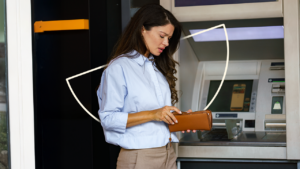What is overdraft protection?

Key takeaways
- Overdraft protection prevents declined transactions by automatically transferring money from a linked account when your balance runs low.
- The service can link to your savings account, credit card or line of credit to cover shortfalls.
- Most banks don’t charge fees for transfers from linked savings accounts, but may charge for credit-based transfers.
- You can opt out of overdraft protection entirely if you prefer transactions to be declined when funds are insufficient.
Overdraft protection acts as a financial safety net when your checking account balance can’t cover a transaction. Instead of facing a declined card or bounced check, the bank automatically moves money from another source to cover the shortfall.
This optional service has become more important as the average overdraft fee reached $26.77 in 2025, according to Bankrate’s latest checking account survey. While overdraft protection can help you avoid these costly fees, it’s not always free — and it’s not right for everyone.
How does overdraft protection work?
An overdraft occurs when you spend more money than you have available in your checking account. Without protection, this typically results in declined transactions or returned checks, plus fees from your bank.
When you set up overdraft protection, your bank links your checking account to a backup funding source. The moment a transaction would push your balance negative, the bank automatically transfers money to cover the difference.
You have three main options for overdraft protection funding:
- Linked savings account: The most common and typically cheapest option. When you need extra funds, money transfers from your savings to checking. Most banks don’t charge fees for these transfers, making this the most cost-effective choice.
- Line of credit: Your bank extends a small loan to cover the overdraft. You’ll pay interest on the borrowed amount, similar to a credit card balance. This option works well if you can repay the money quickly.
- Linked credit card: The bank processes a cash advance from your credit card to cover the shortfall. This option usually comes with cash advance fees plus interest charges, making it the most expensive choice.
Example of how overdraft protection works
Let’s say you have $30 in your checking account and stop for gas that costs $45. Here’s what happens with different scenarios:
Without overdraft protection: Your debit card gets declined at the pump, leaving you unable to fill up your tank. Some banks might process the transaction anyway and charge you an overdraft fee of around $27.
With overdraft protection (linked savings): Your bank automatically transfers $15 from your savings account to checking, allowing the gas purchase to go through. Most banks don’t charge a fee for this transfer.
With overdraft protection (credit card): Your bank processes a $15 cash advance from your linked credit card. You’ll likely pay a cash advance fee (often $10 or 3% of the amount) plus immediate interest charges on the $15.
Which banks offer overdraft protection?
Most major banks provide overdraft protection options, though the specific terms and fees vary significantly:
| Bank | Type | Fee |
|---|---|---|
| Bank of America | Linked deposit account | $0 |
| Chase | Linked deposit account | $0 |
| Citizens Bank | Linked deposit account | $0 |
| Commerce Bank | Linked credit card | 5% of the transfer amount (with a $10 minimum) plus interest at the cash advance rate |
| Fifth Third Bank | Linked deposit account | $12 per occurrence with Essential Checking, unless the overdraft is $5 or less |
| TD Bank | Linked deposit account | $0 |
| U.S. Bank | Line of credit | Variable-rate APY on money you borrow |
Note: Some banks may offer additional overdraft protection funding options than the options listed in the table above.
Many online banks also offer overdraft protection, often with more generous terms than traditional banks. Some even provide small buffer amounts — like covering overdrafts up to $100 — without any fees or required linked accounts.
Pros and cons of overdraft protection
Overdraft protection can be a useful tool, although it’s important to consider its benefits and downsides before deciding if the service is right for you.
Pros
Overdraft protection offers several advantages for managing unexpected shortfalls. You avoid the embarrassment of declined transactions at checkout, and your important payments continue processing even when your timing is off.
The protection also prevents bounced check fees from merchants, which can range from $25 to $40 on top of your bank’s charges. For people with unpredictable income or tight budgets, this safety net provides peace of mind.
Cons
The downsides depend on your funding source. Credit card-based protection can lead to expensive cash advance fees and immediate interest charges. Some people treat overdraft protection as extra spending money, leading to repeated use and mounting costs.
If you’re using a credit line or credit card for protection, frequent overdrafts can increase your credit utilization ratio and potentially hurt your credit score. The convenience might also mask underlying budgeting problems that need attention.
Additionally, if your linked savings account doesn’t have enough money to cover an overdraft, your transaction will still be declined — defeating the purpose of the protection.
How to avoid overdraft fees
The best overdraft protection is not needing it at all. Several strategies can help you maintain a positive account balance:
- Monitor your balance regularly. Check your account daily through your bank’s mobile app. Most apps show pending transactions, giving you a real-time view of your available funds.
- Set up balance alerts. Most banks offer text or email notifications when your balance drops below a threshold you set. A $50 alert gives you time to transfer money or postpone purchases.
- Use a high-yield savings account for overdraft protection. This keeps your emergency buffer earning interest while it’s not needed. Many online banks offer savings accounts paying over 4% APY.
- Consider banks with low-fee or no-fee overdraft policies. Some banks have eliminated overdraft fees entirely, while others offer small buffer amounts without charges. Compare checking accounts to find banks with customer-friendly policies.
- Build a small cushion in your checking account. Keeping an extra $100-200 in checking provides a natural buffer against small overdrafts without needing to link other accounts.
- Create a budget and stick to it. Understanding your income and expenses helps prevent spending more than you have. Free budgeting apps can help track your spending in real-time.
- Opt out of overdraft coverage entirely. If you prefer transactions to be declined rather than risk fees, you can tell your bank not to cover overdrafts. Your debit card will be declined if you don’t have sufficient funds, but you won’t face any overdraft charges.
Bottom line
Overdraft protection can be a useful safety net, but it’s not a long-term solution for money management problems. The best approach is linking a savings account for occasional protection while building better spending habits.
If you frequently rely on overdraft protection, it might be time to reassess your budget or consider a checking account with more favorable overdraft policies. Many banks now offer accounts with no overdraft fees or small buffer amounts to help customers avoid charges entirely.
Remember that overdraft protection is optional — you can always opt out if you prefer to have transactions declined rather than risk fees or debt accumulation.
Why we ask for feedback Your feedback helps us improve our content and services. It takes less than a minute to complete.
Your responses are anonymous and will only be used for improving our website.






